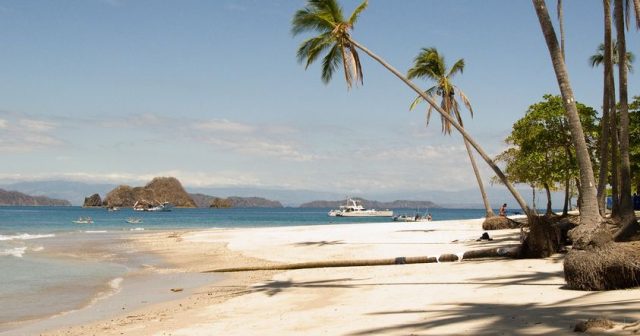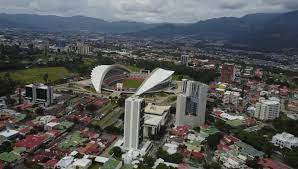Costa Rica has a warm climate all year round in the plains and on the coasts, and more temperate in the cities located on the plateaus (in the so-called temperate lands). The temperature differences between one month and another are not very significant, because Costa Rica is located near the equator. Therefore, the trend of the seasons is mainly related to the rains. However, most of the country is so rainy that it is covered by tropical forests.
The Pacific coasts and the interior plateau have a dry season (December to April) and a rainy season (May to November) with heavy rains, while the eastern coasts and plains (but also the southernmost part of the Pacific coast) have an equatorial climate, with abundant rainfall throughout the year.
Along the eastern coast of Costa Rica and in the plain exposed to the Caribbean Sea, the climate is very rainy, with more than 3,000 millimeters per year, and can be defined as equatorial without a dry season, because the northeast trade winds, that blow from November to April, they hit them directly.
However, there are 2 rain peaks (July and December with approximately 400 millimeters) and 2 relative lows: September-October and February-March, with approximately 150/200 millimeters per month. In this area, December is even the rainiest month, and January is rainier than February and March. South of this coast, on the mountainous slopes of the Braulio Carrillo National Park, rainfall reaches 5,000 millimeters (5 meters) per year.
Puerto Limón
Along the coast of the Caribbean Sea there is a humid heat throughout the year, as the winds constantly blow from the sea.
Pacific Coast

The Pacific coast is slightly warmer than the Caribbean coast, especially in winter, when the northeast trade winds descend from the mountains and produce intense but dry heat (average daytime temperatures are around 30/32 °C in the less hot period, from October to November, and can reach 34/35 °C in March and April, before the rainy season).
Here there is a well-defined dry season from November to April, at least in the north-central part, while towards the south, the dry season becomes shorter and shorter (it rains quite a lot even in December and April), and in the part In the south, the climate even becomes equatorial, as on the coast of the Caribbean Sea.
The north-central part (Guanacaste province, Puntarenas canton) is particularly hot from February to April, it is also the least rainy area of the country, since rainfall varies between 1,300 and 1,600 millimeters per year, and dominates the savannah.
Puntarenas
In Quepos, the sun shines especially from February to April but, in general, it is seen for a few hours a day, even in the rainiest months. This is because rains, however intense, usually occur in the afternoon or at night.
Near Quepos we find the Manuel Antonio National Park. Further south, on the Osa Peninsula and in the Golfo Dulce it rains even more: in Golfito 4,100 mm of rain falls per year, and there is no real dry season, despite the fact that between January and March around 100 mm falls per year/month. A tropical forest grows in Corcovado National Park.
The climate is also equatorial on Coco’s Island, located in the Pacific Ocean, far to the south of the continent.
Sea temperature
The sea in Costa Rica is warm all year round, as can be seen in the following table relative to the sea temperature in Quepos, located on the Pacific coast (but on the Caribbean Sea coast, the temperature is similar).
Hills and mountains
In the inland areas, between the two coasts we find two mountain ranges, the Central Mountain Range and the Talamanca Mountain Range.
San José

The capital city, San José, is located in the central part, on the plateau between the 2 mountain ranges, at 1,100 meters of altitude; that is, in the temperate lands and, therefore, has a pleasant temperature throughout the year, with cool nights and pleasantly warm days.
In San José it rains little from December to April, and from January to March almost never. The rainy season runs from May to November, and the wettest months are September and October, with approximately 300 millimeters per month. Here is the average rainfall.
Mountains
In high mountain areas, at more than 2,000 meters, in the so-called cold lands, and even more on the slopes of the mountains and the highest volcanoes, such as Cerro Chirripó (3,820 meters) or the Irazù Volcano (3,431 meters), temperatures become low, especially in the rainy months. Above 3,500 meters at night there can be frosts throughout the year.
Hurricanes
Costa Rica is almost always safe from hurricanes from the Caribbean Sea, which move at a slightly higher latitude: they can sometimes affect neighboring Nicaragua, so the riskiest areas are those to the north, which may be indirectly interested. The hurricane period runs from June to November (although they are more likely to occur in October and November), during the rainy season, which is generally not recommended for tourists.
The first hurricane to hit Costa Rica directly was Otto in November 2016, although Hurricane Nate, which formed in the sea east of the country in October 2017 and then moved north, has caused even more serious damage.
It is also necessary to consider the presence of depressions and tropical storms that can form in the Pacific: they are generally not intense because they affect the country in the early stages of their formation, and then move towards the northwest, remaining over the ocean, but they can be Either way bring heavy rains, which can cause landslides and landslides.
When to go to Costa Rica (and what to wear)

The best time to visit Costa Rica, whether you want to live on the beach, visit cities or explore its rich animal and plant life, is from January to mid-April, and in particular the months of February and March. Almost everywhere it is hot, sunny and rains little, except on the east coast, which has a hot and humid climate with frequent rains throughout the year. The capital can also be visited in December.
In the northwest (Guanacaste province, Puntarenas canton), considering that in December it already rains little, and then in the spring it is very hot, it is possible that the months of December and January are preferred.
In the southwest (southern part of the province of Puntarenas, versus Quepos and Golfito, Osa Peninsula), since it still rains a lot in December, you can go from January to mid-April.
On the Caribbean coast, you can choose the months of February and March.
For San José and the temperate lands: all year round, light clothing, a sweatshirt or sweater for the night; raincoat or umbrella from May to November.
For the plains and the coasts: very light clothing; in the rainy season, a light sweatshirt, and a light raincoat for storms. For the high-mountain climate: warm clothing, anorak, trekking shoes.


